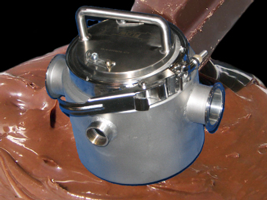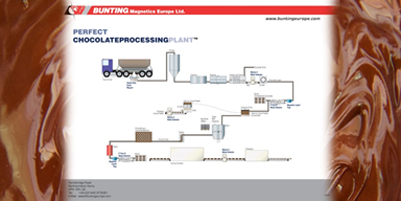Getting metal out of chocolate
- Like
- Digg
- Del
- Tumblr
- VKontakte
- Buffer
- Love This
- Odnoklassniki
- Meneame
- Blogger
- Amazon
- Yahoo Mail
- Gmail
- AOL
- Newsvine
- HackerNews
- Evernote
- MySpace
- Mail.ru
- Viadeo
- Line
- Comments
- Yummly
- SMS
- Viber
- Telegram
- Subscribe
- Skype
- Facebook Messenger
- Kakao
- LiveJournal
- Yammer
- Edgar
- Fintel
- Mix
- Instapaper
- Copy Link
Posted: 8 August 2016 | Bunting Magnetics | No comments yet
A Guide to the Best Locations for Magnetic Separators and Metal Detectors in a Chocolate Production Line…


Chocolate is made from the exceptionally hard cocoa bean and this means that metal gets introduced into the process, especially from equipment wear.
However, a series of carefully selected and placed Metal Detectors and Magnetic Separators will remove any metal from the process before it becomes a bar that is loved by millions.


The Stages of Metal Removal
Stage 1 – When the cocoa beans are discharged from the delivery vessel, metal is removed by passing all the beans through a heavy duty Grate Magnet. This captures any larger ferrous metal, like nails, nuts and bolts.
Stage 2 – After the cocoa beans have been cleaned and roasted, they are cracked with the shells being discarded and the nuts being fed into the process. After cracking, the nuts can be fed on a conveyor through a Metal Detector (Metron C) before passing onto the grinder. This protects the grinder from being damaged by metal freed in the cracking process.
Stage 3 – After the grinder, the nuts have been converted into a chocolate liquor. The process of grinding will introduce fine metal into the process and this is removed with a Magnetic Liquid Trap followed by a P-Tron Metal Detector.


Stage 5 – The cocoa butter is fed onto a mixer where sugar, milk and flavouring is added. After mixing and passing through a series of rollers, the mixture is emulsified before being heated. This molten hot mix is then passed through a Magnetic Liquid Trap with a waterjacket (the hot water in the waterjacket stops any material from cooling). Care has to be taken in selecting the right magnets as high temperatures can irreversibly damage the magnetic field. The magnets must be suitable for use in high temperature environments. After the Magnetic Liquid Trap, the mixture is passed through a P-Tron Metal Detector to detect any non-ferrous metal that may still be present. This joint protection is important to prevent damage to the next stage of the process (the moulds).
Stage 6 – After the chocolate is fed into moulds it is then cooled. The final check is after cooling, when the moulded and formed chocolate is then fed on a conveyor through a Metal Detector (Metron C). The metal-free chocolate is then packaging and despatched for sale to the millions of chocolate lovers all over the world.
Multi-stage Metal Detection and Magnetic Separation may appear excessive, but the best way to remove all metal from the process is to focus on areas where metal may be introduced or released as part of the production process.
For further information on ‘Getting Metal Out’ of Chocolate or any foodstuffs, please contact us on:
- [email protected]
- call us on 01442 875081
- Send an enquiry via our website




